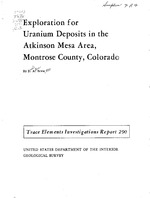The U.S. Geological Survey explored the Atkinson Mesa area for uranium- and vanadium-bearing deposits from July 2, 1951, to June 18, 1953, with 397 diamond-drill holes that totaled 261,251 feet. Sedimentary rocks of Mesozoic age are exposed in the Atkinson Mesa area. They are: the Brushy Basin member of the Upper Jurassic Morrison formation, the Lower Cretaceous Burro Canyon formation, and the Upper and Lower Cretaceous Dakota sandstone. All of the large uranium-vanadium deposits discovered by Geological Survey drilling are in a series of sandstone lenses in the upper part of the Salt Wash member of the Jurassic Morrison formation. The deposits are mainly tabular and blanket-like, but some elongate pod-shaped masses, locally called "rolls" may be present. The mineralized material consists of sandstone impregnated with a uranium mineral which is probably coffinite, spme carnotite, and vanadium minerals, thought to be mainly corvusite and montroseite. In addition,, some mudstone and carbonaceous material is similarly impregnated. Near masses of mineralized material the sandstone is light gray or light brown, is generally over 40 feet thick, and usually contains some carbonaceous material and abundant disseminated pyrite or limonite stain. Similarly, the mudstone in contact with the ore-bearing sandstone near bodies of mineralized rock is commonly blue gray, as compared to its dominant red color away from ore deposits. Presence and degree of these features are useful guides in exploring for new deposits.


